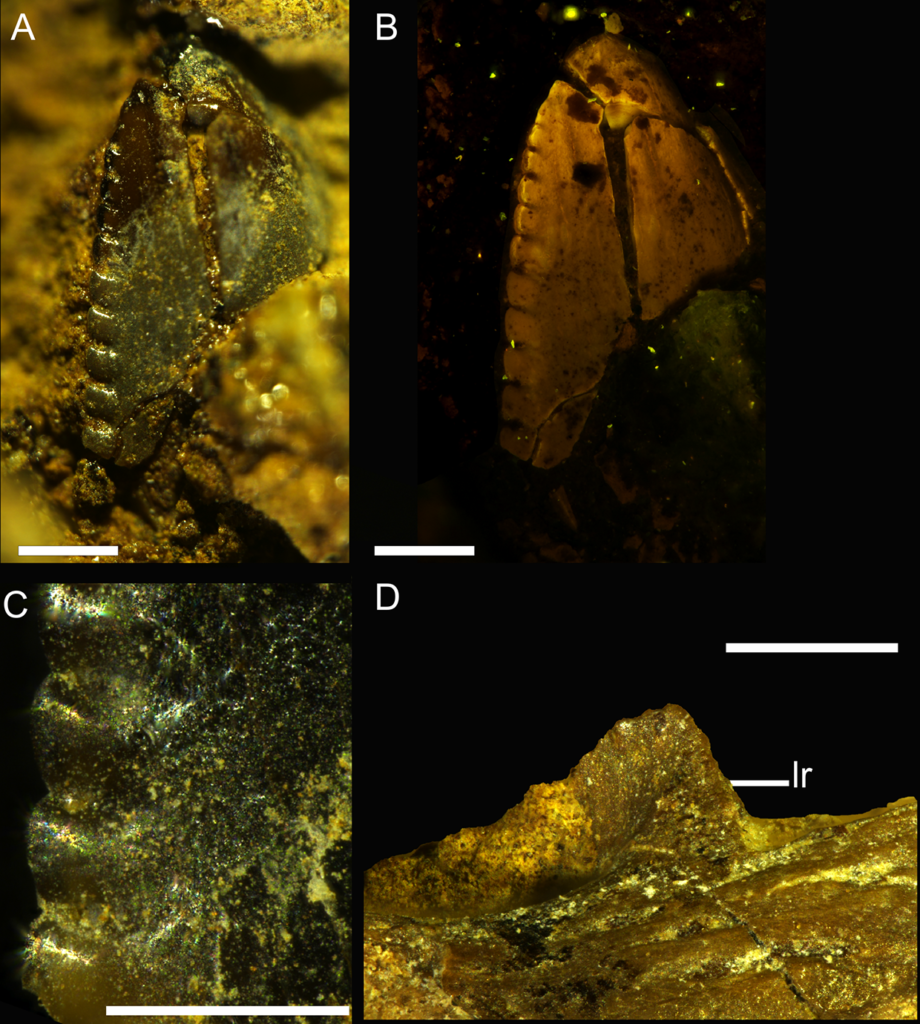@WFS,World Fossil Society,Riffin T Sajeev,Russel T Sajeev

Closeup on the dentary teeth and lateral ridge in DMNH 21183.
Detail of the 2nd dentary tooth highlighting the distal carina under normal light (A) and fluorescent microscopy (B). Details of the distal denticles (C) and close-up of the lateral ridge (lr) close to the alveolar margin in lateral views (D). Abbreviation: lr, lateral ridge. Scale bar: 0.5 mm.
Compared to the osteological record of herbivorous dinosaurs from the Late Cretaceous Prince Creek Formation of northern Alaska, there are relatively fewer remains of theropods. The theropod record from this unit is mostly comprised of isolated teeth, and the only non-dental remains known can be attributed to the troodontid cf. Troodon and the tyrannosaurid Nanuqsaurus. Thus far, the presence of members of Dromaeosauridae has been limited to isolated teeth. Here we describe a symphyseal portion of a small dentary with two ziphodont teeth. Based on tooth shape, denticle morphology, and the position of the Meckelian groove, we attribute this partial dentary to a saurornitholestine dromaeosaurid. The fibrous bone surface, small size, and higher number of mesial denticles compared to distal ones point to a juvenile growth stage for this individual. Multivariate comparison of theropod teeth morphospace by means of principal component analysis reveals an overlap between this dentary and Saurornitholestinae dromaeosaurid morphospace, a result supported by phylogenetic analyses. This is the first confirmed non-dental fossil specimen from a member of Dromaeosauridae in the Arctic, expanding on the role of Beringia as a dispersal route for this clade between Asia and North America. Furthermore, the juvenile nature of this individual adds to a growing body of data that suggests Cretaceous Arctic dinosaurs of Alaska did not undergo long-distance migration, but rather they were year-round residents of these paleopolar latitudes.
Citation: Chiarenza AA, Fiorillo AR, Tykoski RS, McCarthy PJ, Flaig PP, Contreras DL (2020) The first juvenile dromaeosaurid (Dinosauria: Theropoda) from Arctic Alaska. PLoS ONE 15(7): e0235078. https://doi.org/10.1371/journal.pone.0235078
Editor: Laura Beatriz Porro, University College London, UNITED KINGDOM
@WFS,World Fossil Society,Riffin T Sajeev,Russel T Sajeev



 July 13th, 2020
July 13th, 2020  Riffin
Riffin  Posted in
Posted in  Tags:
Tags: 